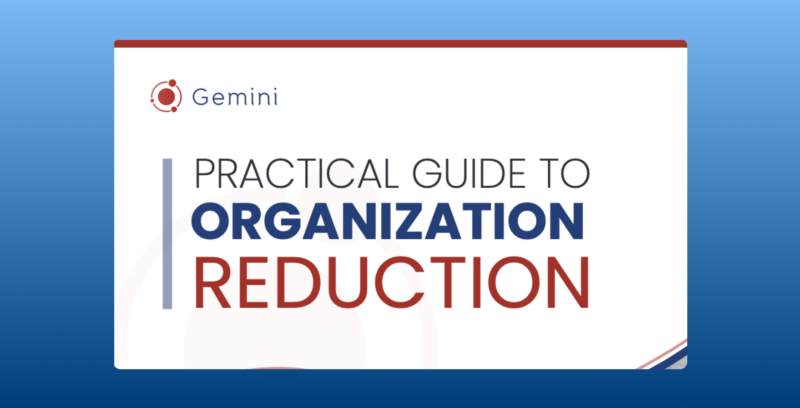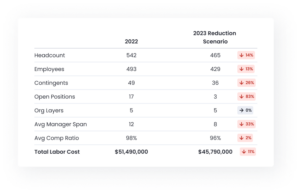An HR Leader’s Practical Guide for Organizational Restructuring
Organizational restructuring is a complex and challenging process that requires careful planning, execution, and communication. As an HR leader, you play a critical role in guiding your organization through this change, ensuring that the restructuring is aligned with the company’s strategic goals, and minimizing its impact on employees.
In this blog, we will walk you through the key steps involved in organizational restructuring. Whether you are restructuring due to a merger or acquisition, a change in business strategy, or other reasons, this blog will provide you with the knowledge and tools to navigate the process with confidence and competence. Let’s get started on this important journey!
THE BIG PICTURE IN ORG RESTRUCTURES
A). Before an Org Restructure begins, get clear on Goals and Priorities
In addition to the overall reduction target number, ask Executive Management to prioritize each Group and Function area based on strategic considerations. Make sure the prioritization is sequential as not everything can be a top priority. Also have Executive Management assign a % reduction target to each area based on the priorities.
B.) There is Useful Industry Information to Consider
There are several redesign levers that should always be considered where industry comparison information is readily available. Formally review this information with Executive Management prior to other steps. This information is also useful in creating a proposed Org Structure that Senior Management will need to draft individual resources into. Executive Management can also use this information to adjust % reduction per area and prep the difficult conversations.
- Best practice company size and ratio benchmarks
- Overall management layers and spans of control
C.) Gather employee information
When considering individuals to move forward with in a redesigned organization, have performance and culture fit scores readily available prior to making decisions. In particular, have available your current leaders’ function/team KPI performance, past leadership assessments, 360 feedback from employees and document where those leaders are in succession plans.
D.) Be inclusive (as you can be) in decision making
Successful org reduction projects are built on a foundation of comprehensive analysis and collaborative iteration. Ideally, there is a core group of senior leaders that would collabo- rate and draft employees into a restructured organization. However, the Executive group that prioritizes functions and groups sets the reduction targets and creates the initial org design that should be very small.
ORGANIZATION RESTRUCTURE PROCESS
The following is focused on the structural how and who is engaged to make decisions. This process does not include the communication plan and execution steps. This process also assumes that there are not going to be any reductions to the core executive team and that the reduction can be achieved with senior management engagement. For information or assistance on a “radical” restructure that includes reduction of executive/senior management and/or combining departments/functions, please contact the Gemini services team at Gemini.
- Get the Number – The executive team needs to set an overall target reduction number. This should be expressed as a percent of labor cost to reduce in each area. Reductions in other, non-labor areas, should have been completed in another exercise and/or expressed as a different target.
- Set Department/Function Targets – Ideally, there is a core group of senior leaders that would be responsible for goal seeking in their respective organizations to hit their area targets. The function targets would vary based on prioritized company strategies. The fastest way to set per area reduction targets is for a seasoned HR leader to complete the first draft and then review and iterate with the core executive team. Whatever executive decision-making process is typically used for major decisions would be deployed here. Ultimately, the CEO would make the final call on reduction targets.
- Collaborate – The senior leaders should be reporting their revised organization draft, with employees on the “bench” that will not potentially be in their organization. HR should be continually reviewing benched employees for individual performance and HR risk. High performing employees should be discreetly communicated to other senior leaders who could potentially use the talent. HR is responsible for managing all the different scenarios, making sure targets are met and checking to see if the overall target has been met. There should be a process for escalation to the Executive Team if a senior manager requests reduction target changes.
- Prioritize Strategies – Prioritize company strategies and OKRs (objectives, key results). Engage with the executive team to stack rank strategies/OKRs on a 1-X scale. Strategies and OKRs generally translate to functions and roles that can execute on those strategies.
- Send Information Packets – The senior leaders responsible for reduction targets should be sent the target, communication plans, a copy of their downline, location of employee performance information, the prioritized strategies and instructions on how to report back their reduction scenario(s). There also needs to be a clear process on how to handle employees who are “benched” in one organization but who the senior manager feels could be available to work in another organization.HR should set a minimum level of past performance for an employee to be available for “drafting” into another organization.
- Set Department/Function Targets – Ideally, there is a core group of senior leaders that would be responsible for goal seeking in their respective organizations to hit their area targets. The function targets would vary based on prioritized company strategies. The fastest way to set Department/Function targets if for a seasoned HR leader to complete the first draft and then review/brainstorm with the executive team. Whatever executive decision-making process is typically used for major decisions would be deployed here. Ultimately, the CEO would make the final call on targets.
- Consolidate and Report – As the HR leader, you will need to consolidate all the various scenarios from senior manage- ment and prep the draft recommendation for executive review.Major areas should be highlighted, including team/group consolidation, needed promotions, individual risk situations and strategic priorities that may need to be compromised. The draft org chart should be easy to navigate and read, with all changes highlighted.For those individuals left without a home, the pertinent performance, time of service and expected severance cost should all be easily accessible.
- Operations Plan – As the HR leader, you will need to include a draft communication and timeline plan that include who is notified, how they are notified and when activities are to occur.
Making the decision to restructure an organization for the purposes of cost-cutting is never easy. The purpose of this blog was to provide a simple resource for aligning strategy to difficult decision making. For more information you can download our Free Org Restructure Guide or Contact Our Team for help.





